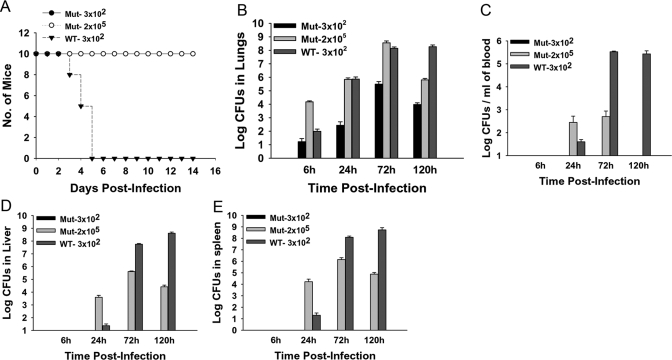Figure 1.
The 58-kDa mutant is highly attenuated in vivo. Mice were inoculated intranasally with 3 × 102 CFUs of the WT or 3 × 102 or 2 × 105 CFUs of Mut bacteria in 20 μl PBS. Mock control mice received 20 μl PBS alone. (A) Survival of the mice was recorded daily over a period of 3 weeks. WT-infected mice showed disease symptoms by 72 h and became moribund and succumbed to infection by 120 h p.i., whereas mutant-infected mice remained healthy throughout the infection period; n = 10/group for this representative of three experiments. (B) Bacterial burden was enumerated in lungs harvested from Mut- and WT-infected mice at 6, 24, 72, and 120 h p.i. Mice infected with 3 × 102 CFUs of the Mut bacteria displayed lower bacterial loads than those infected with similar doses of the WT bacteria at all times p.i.-tested. Bacterial loads in mice infected with 2 × 105 CFUs of Mut bacteria were higher than WT-infected mice at 6, 24, and 72 h p.i. By 120 h p.i., the bacterial burden was reduced in Mut-infected mice, whereas it remained high in WT-infected mice at that time; n = 3–5/group. A Representative of three independent experiments is shown. Bacterial burden in (C) blood, (D) liver, and (E) spleen of mice infected with 3 × 102 CFUs of WT or 2 × 105 CFUs of Mut bacteria. No bacterial loads were detected in these organs from mice infected with 3 × 102 CFUs of Mut bacteria. n = 3–5/group. A Representative of three independent experiments is shown.

